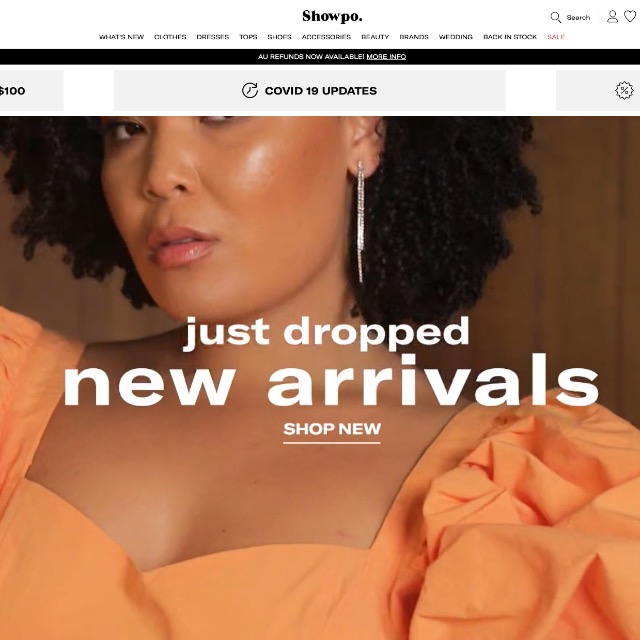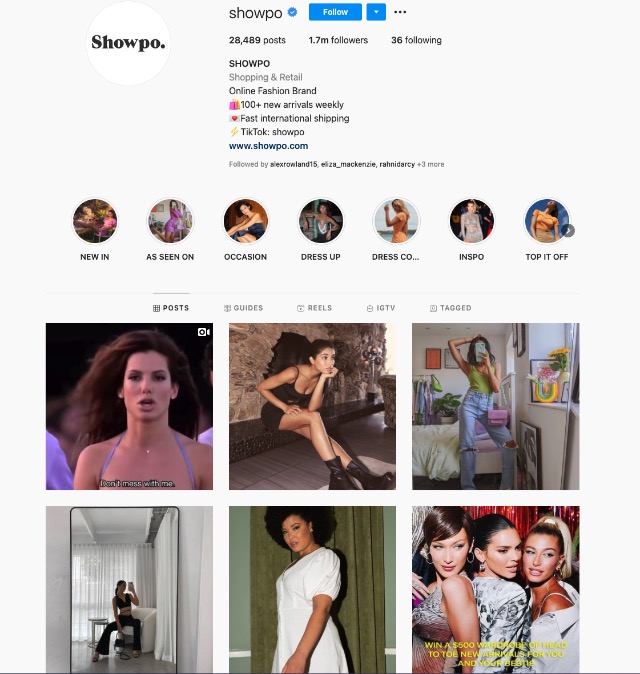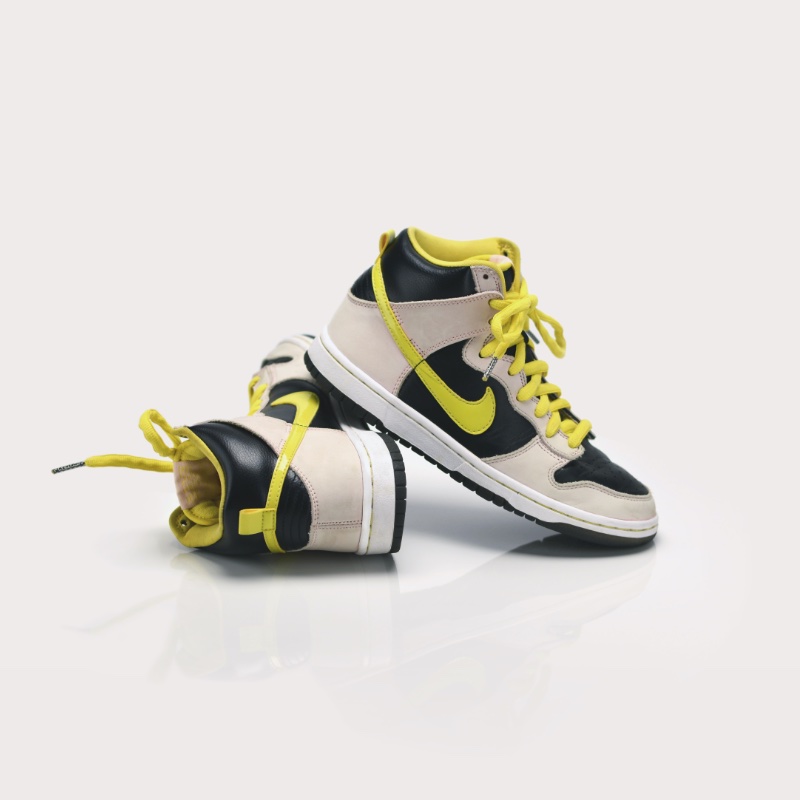Showpo, like many great Australian business stories, started in founder Jane Liu’s parents’ garage in Sydney in 2010. CEO and Co-founder, Jane, had gone from a job in corporate finance to a failed business venture running pop-up stores for emerging designers across Sydney. She was in debt and afraid to tell her parents.
These days, the business rakes in $85 million in revenue.
She attributes some of the brand’s success to good timing. 2010 was very much the beginning of e-commerce for fashion retailers, especially those doing much of their marketing via social media.
But it’s undeniable that their digital marketing strategy has something to do with this. Their strategy, in order to connect with a young and fast-paced target audience, is to be extremely active and highly relevant across a variety of social channels, and specifically engage with a host of micro-influencers.
Showpo’s website appeals to a younger audience of GenZers and millenials.
SOCIAL CONTENT MARKETING
Like many brands appealing to millennials and Gen-Zers, Showpo is incredibly active across all of its social media channels. They have a collective 4 million followers across their channels, all of which share relevant, interesting content for users to consume.
This young target audience, says former Showpo CMO Mark Baartse, is constantly on the move, looking for the latest trends. With the massive reach of social media, these young women (generally) are able to change their minds about what is cool and what is not within a matter of minutes.
Therefore, the marketing team has to be constantly ‘on the ball’ when it comes to keeping up with the latest trends.
Unlike most brands, Showpo does not limit itself to one or even a few select social channels. Instead, they go big and have an active presence on Instagram, TikTok, Pinterest and Facebook.
The brand is most active on their Instagram account, but they are diversified across a number of channels.
On Instagram, they intersperse images of models wearing their clothing with influencers’ images and inspirational content. They also capitalise heavily on their ability to share ‘swipe up’ links in stories and on posts, for example. This makes for very easy shopping for users as they will be directed straight to an appropriate landing page.
Instagram is undoubtedly their largest and most successful platform at the moment, although the brand’s desire to keep up with their young audience will probably see this change if Millennials and Gen-Zers were to jump ship and pick a new platform of choice.
On Facebook, they re-share similar content in terms of advertising, but they intersperse this with more ‘relatable’ memes. This divergence in strategies clearly relates to the different ways Millennials and Gen Z use the two platforms. Facebook has always been much more about funny, slightly useless content for users to tag their friends in, whereas Instagram is for ‘style inspo’ from influencers and celebrities. On Facebook, clearly branded content such as images of models in their clothing normally receives minimal likes, whereas memes can garner a couple of hundred likes, shares and comments. This is a great way of driving engagement based on content rather than sales.
Their TikTok platform is largely similar to Instagram in that they share ‘outfit inspiration’ – whether from celebrities, movies like Mean Girls that obviously resonate well with their target audience or from their own models/influencers. Many of these short videos are then shared to Instagram as reels.
Pinterest is utilised largely for sharing only their own content and organising it by mood boards. Surprisingly, this platform averages more than 10 million views a month which is quite astounding.
It’s an ‘always on’ marketing strategy that relies on business as usual rather than a few annual or seasonal campaigns to drive sales. This is not to say, of course, that Showpo does not also heavily advertise during major sales such as Black Friday – where they say more purchasing behaviour occurs than traditionally later in December.
MICRO-INFLUENCER MARKETING
Using Instagram ‘influencers’ helps the brand reach new audiences.
Rather than posting images of faceless models, Showpo relies on many, many micro-influencers who post pictures of themselves wearing the brand’s clothing on their own feeds, which are then re-shared by Showpo. This generates cross-sharing and exposure to new customers. Adding the tag of the influencer makes this person seem much more ‘real’ than traditional models in glossy magazines.
Millennial users then follow the influencers, driving engagement across both accounts. It’s really a win-win for both parties.
Micro-influencers are commonly called the ‘future’ of digital marketing because they are so influential when it comes to shaping the opinion of others. For many, it feels more like being given the opinion of a trusted friend or confidante.
For young people who have grown up in the digital age, advertising has become normalised and relentless. This generation knows that everybody is trying to sell products, yet when it is ‘sold’ as an opinion by someone they follow for content and already trust somewhat, it’s much less blatant.
Visiting the ‘tagged’ page for the Showpo Instagram page will reveal an absolutely enormous number of posts where influencers will have been paid by Showpo to share an image of themselves wearing the brand’s clothing (normally denoted by #ad). Even more posts will have been put up by women sporting Showpo outfits, who tag the brand in order to increase their own online profile. These posts can have anywhere from a couple to a couple of thousand likes, and will come from all over the world.
FAST 5
- Showpo’s fast rise to success can be attributed to its willingness to diversify and cross-post across all the major social channels – Instagram, TikTok, Facebook and Pinterest.
- Their content is specifically geared across these platforms as to what drives the most engagement.
- Instagram is clearly their largest and most successful social media channel. Here, they post their own branded content as well as outfit inspiration from models and influencers.
- Facebook is second, and largely used for light-hearted memes and content marketing, driving engagement through shares, comments and likes.
- Micro-influencers, as well as those who aspire to be, have been a gold-mine when it comes to brand awareness and advertising in a ‘genuine’ way. Influencers also have their own status improved due to being featured on Showpo’s page, and Showpo gains access to legions of followers across the world it might not otherwise touch.





